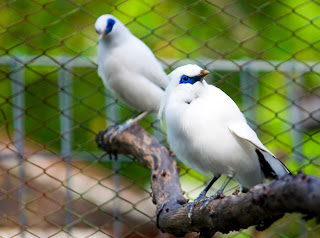Bali starling is the mascot of Bali. Bali Starling is the pride of the people of Bali. These beautiful birds are appropriately protected by all parties of extinction.
1. History
Its discovery was first reported by Dr. Baron Stressmann an ornithologist nationality British on March 24, 1911. On the recommendation Stressmann, Dr. Baron Victor Von Plessenn conduct advanced research (1925) and find the Bali Starling bird spread from Bubunan to Gilimanuk wide with an approximate spread of 320 km2. In 1928 a 5 tail Bali Starling brought to England and successfully cultured in 1931. Sandiego Zoo in the United States to breed the Bali Starling in 1962 (Rindjin, 1989).
2. Status
* Since 1966, the IUCN (International Union for Conservation of Nature and Natural Resources) have entered into the Bali Starling Red Data Book, which is a book that contains species of flora and fauna threatened with extinction.
* In international trade convention for the bodies of wild CITES (Convention on International Trade in Endangered Species of wild fauna and flora) Bali Starling was listing in Appendix I, ie groups that are threatened of extinction and banned for trade.
* The Indonesian government issued the Decree of the Minister of Agriculture. 421/Kpts/Um/8/70 dated August 26, 1970, stating among other Bali Starling bird protected by law.
* Be categorized as animal species endemic Bali, namely, those animals were only found on the island of Bali (currently only in the West Bali National Park Area), and wildlife hemisphere never encountered anywhere in the world.
* The Provincial Government of Bali Province Symbol serve as the Fauna of Bali.
3. Morphology
In Biology, Bali Starling has a classification as follows: Phylum (Chordata), Order (Aves), Family (Sturnidae), Species (Leucopsar rothschildi Stressmann 1912) with the local name of Bali Starling, Curik White, White Bali Starling.
As for the characteristics of the Bali Starling can be stated as follows:
* Feathers
Most of the Bali starling feathers pure white, except the tail feathers and black wing tip.
* Eye
Dark brown eyes, the area around the eyelids, lint with a dark blue color.
* Crest
Bali Starling bird has a beautiful crest, either on the sex of males and females.
* Legs
Bali Starling has gray legs blue with 4 fingers (one back and three forwards).
* Beak
With a long pointy beak 2-5 cm, with a distinctive form where at the top there is a flattened elevation upright. Color blackish-gray beak with a yellow tip brown.
* Size
Difficult to distinguish the Bali Starling bird body size of males and females, but in general the males slightly larger and has a longer pigtail.
* Eggs
Bali Starling has egg-shaped oval bluish-green with the longest average diameter of 3 cm and the smallest diameter of 2 cm.
4. Breeding season in the Habitat
In the habitat (natural) Bali Starling showed the breeding period of the rainy season, ranging in November until to May.
5. Habitat, Distribution and Population
Last Habitat Bali Starling in Bali Barat National Park exist only on the Peninsula Prapat Agung (exactly Brumbun Gulf and the Gulf Kelor). This is interesting because in the annals of the spread of Bali Starling never get to the area Bubunan - Singaraja (± 50 km east region).







1 comments:
There is a large wild population of Bali Starlings on the small island of Nusa Penida, 15km south west of Bali. This population was introduced to by the Indonesian NGO / Yayasan called FNPF (Friends of the National Parks Foundation).
FNPF has transformed the whole island of Nusa Penida into a sanctuary for endangered Indonesian birds. This was achieved by winning the support from all 41 villages on the island. Each village has passed a local traditional customary law (awig awig) making it obligatory for all community members to protect birds. In return FNPF runs many projects to benefit the communities, such as education scholarships, free tree and organic vegetable nursery, community library, english language lessons, etc.
FNPF rehabilitates and release endangered bids onto the Nusa Penida Island so that they can live in the wil and rebuild their numbers in safety. The greatest threat to endangered birds in Indonesia is being captured by local people and sold to the lucrative illegal bird market.
FNPF has focussed especially on saving the Bali Starling, one of the world's most endangered birds and Bali's official mascot animal. Despite hundreds of Bali Starlings having been released into West Bali National Park, over the last 20 years, there were less than 10 remaining in the wild in 2005.
Conversely, since 2006 FNPF has release just 74 Bali Starlings onto Nusa Penida island. At least 3 generations of Bali Starlings have bred on Nusa Penida since the first release in 2006, and there were at least 100 living in the wild in 2010.
For more information visit
http://www.fnpf.org/what-we-do/nusa-penida-bali/wildlife/bali-starling-conservation-project
Post a Comment